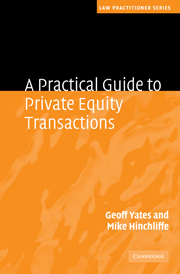Book contents
- Frontmatter
- Contents
- List of figures
- Foreword
- Preface and acknowledgments
- Table of cases
- 1 An introduction to private equity
- 2 The deal process and preliminary matters
- 3 Transaction structures and deal documents
- 4 Acquisition issues
- 5 Equity documentation
- 6 Debt funding
- 7 Employment-related issues
- 8 Pensions
- 9 Tax on private equity transactions
- 10 Public-to-private transactions
- 11 Living with the investment
- 12 Secondary buyouts
- 13 Exits
- Index
4 - Acquisition issues
Published online by Cambridge University Press: 04 May 2010
- Frontmatter
- Contents
- List of figures
- Foreword
- Preface and acknowledgments
- Table of cases
- 1 An introduction to private equity
- 2 The deal process and preliminary matters
- 3 Transaction structures and deal documents
- 4 Acquisition issues
- 5 Equity documentation
- 6 Debt funding
- 7 Employment-related issues
- 8 Pensions
- 9 Tax on private equity transactions
- 10 Public-to-private transactions
- 11 Living with the investment
- 12 Secondary buyouts
- 13 Exits
- Index
Summary
Introduction
In this chapter, we will examine the issues that typically arise in relation to the acquisition documentation on a UK management buyout. As has already been explained, there is more to a management buyout than simply the acquisition. The whole exercise requires considerable project management, combining the acquisition process with the funding elements of the transaction, both equity and banking, which are explored in the chapters that follow. The issue is further complicated in a secondary transaction (see chapter 12), where some of the sellers are also part of the buyer team.
We will concentrate on the issues that arise on the acquisition of a private limited company in the UK. Whilst buyouts may be structured such that the assets of Target are acquired rather than the share capital, such instances are relatively rare (other than in distressed or insolvency situations, which are outside the scope of this book), so a share acquisition is assumed. The key contractual document that regulates the terms for the sale and purchase of Target is the acquisition agreement, and much of this chapter highlights the issues arising in the drafting and negotiation of that document which are different as a result of the transaction being a buyout rather than a sale from one trading company to another. This chapter is not intended to be a complete or exhaustive manual on the issues that arise on the acquisition of a private company; whilst it does set out some of the features of a typical deal, the focus is very much on those specific considerations which arise in a private-equity-backed transaction.
- Type
- Chapter
- Information
- A Practical Guide to Private Equity Transactions , pp. 69 - 113Publisher: Cambridge University PressPrint publication year: 2010



